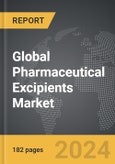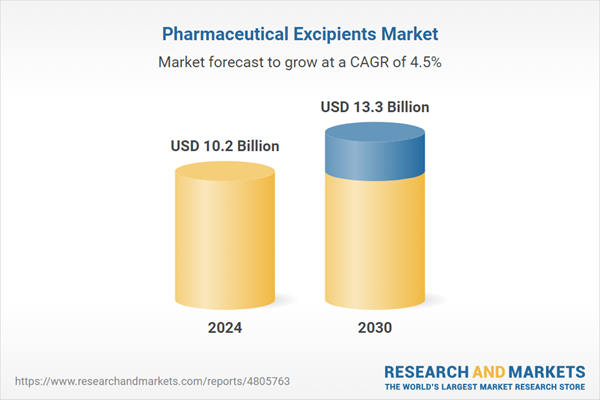The global market for Pharmaceutical Excipients was valued at US$10.2 Billion in 2024 and is projected to reach US$13.3 Billion by 2030, growing at a CAGR of 4.5% from 2024 to 2030. This comprehensive report provides an in-depth analysis of market trends, drivers, and forecasts, helping you make informed business decisions. The report includes the most recent global tariff developments and how they impact the Pharmaceutical Excipients market.
Segments: Type (Organic Chemicals, Inorganic Chemicals, Other Types); Formulation (Oral, Topical, Parenteral, Other Formulations); Functionality (Fillers & Diluents, Binders, Suspending & Viscosity Agents, Flavoring Agents & Sweeteners, Other Functionalities).
Geographic Regions/Countries: World; United States; Canada; Japan; China; Europe (France; Germany; Italy; United Kingdom; and Rest of Europe); Asia-Pacific; Rest of World.
The analysts continuously track trade developments worldwide, drawing insights from leading global economists and over 200 industry and policy institutions, including think tanks, trade organizations, and national economic advisory bodies. This intelligence is integrated into forecasting models to provide timely, data-driven analysis of emerging risks and opportunities.
Global Pharmaceutical Excipients Market - Key Trends and Drivers Summarized
What Are Pharmaceutical Excipients and Why Are They Crucial?
Pharmaceutical excipients are inactive substances that are used in drug formulation to provide bulk, stability, and ease of administration, among other functions. They play a pivotal role in the pharmaceutical industry by enhancing the properties of active pharmaceutical ingredients (APIs) without interfering with their therapeutic effects. Excipients serve various purposes, such as improving the taste and appearance of the final product, ensuring the stability and bioavailability of the drug, and facilitating drug absorption. Common types of excipients include binders, fillers, diluents, disintegrants, lubricants, and preservatives. The selection of appropriate excipients is critical in drug development as they can significantly impact the efficacy, safety, and shelf life of the medication. With the increasing complexity of drug formulations, the demand for specialized and multifunctional excipients has surged, underscoring their importance in modern pharmaceutical manufacturing.How Are Technological Advancements Shaping the Excipient Landscape?
Technological advancements have dramatically transformed the landscape of pharmaceutical excipients, driving innovation and improving the quality of drug formulations. One significant development is the advent of multifunctional excipients that combine several properties into a single substance, reducing the need for multiple additives and streamlining the manufacturing process. Advances in nanotechnology have also led to the creation of nano-sized excipients that enhance drug solubility and bioavailability, particularly for poorly water-soluble drugs. Moreover, the integration of 3D printing technology in pharmaceuticals has opened new avenues for personalized medicine, where excipients are tailored to individual patient needs and specific drug release profiles. The use of sophisticated analytical techniques, such as spectroscopy and chromatography, ensures the purity and consistency of excipients, thereby maintaining high-quality standards in drug production. These technological innovations not only improve the performance of excipients but also support the development of more effective and safer medications.What Role Do Regulatory Standards and Sustainability Play in the Excipient Market?
Regulatory standards and sustainability are pivotal factors influencing the pharmaceutical excipient market. Regulatory bodies, such as the FDA and EMA, impose stringent guidelines on the use of excipients to ensure their safety, efficacy, and quality. Compliance with these regulations is mandatory for pharmaceutical companies, prompting continuous improvement and rigorous testing of excipients. Additionally, there is a growing emphasis on the sustainability of excipients, driven by environmental concerns and consumer demand for eco-friendly products. Manufacturers are increasingly adopting green chemistry principles, utilizing renewable resources, and minimizing waste in excipient production. The development of biodegradable and non-toxic excipients aligns with global sustainability goals and reduces the environmental impact of pharmaceutical manufacturing. Furthermore, transparency in the supply chain and adherence to good manufacturing practices (GMP) are crucial for maintaining the integrity and trustworthiness of excipient suppliers. These regulatory and sustainability trends ensure that the excipient market evolves in a responsible and forward-thinking manner.What Factors Are Driving Growth in the Pharmaceutical Excipients Market?
The growth in the pharmaceutical excipients market is driven by several factors. Firstly, the increasing demand for innovative drug formulations, including controlled-release and targeted delivery systems, is propelling the need for advanced excipients. Technological advancements, such as nanotechnology and 3D printing, are enabling the development of sophisticated excipients that enhance drug performance. Secondly, the rising prevalence of chronic diseases and the growing geriatric population are boosting the demand for pharmaceuticals, thereby expanding the excipient market. Additionally, the trend towards personalized medicine and the development of biologics and biosimilars are creating new opportunities for specialized excipients. Regulatory requirements for drug safety and quality are also driving the adoption of high-purity and compliant excipients. Furthermore, the focus on sustainability and green chemistry in pharmaceutical manufacturing is encouraging the use of eco-friendly excipients. Lastly, increasing R&D investments by pharmaceutical companies to develop novel drug delivery systems and improve existing formulations are fueling market growth. These factors collectively contribute to the dynamic expansion and innovation within the pharmaceutical excipients market.Report Scope
The report analyzes the Pharmaceutical Excipients market, presented in terms of units. The analysis covers the key segments and geographic regions outlined below.Segments: Type (Organic Chemicals, Inorganic Chemicals, Other Types); Formulation (Oral, Topical, Parenteral, Other Formulations); Functionality (Fillers & Diluents, Binders, Suspending & Viscosity Agents, Flavoring Agents & Sweeteners, Other Functionalities).
Geographic Regions/Countries: World; United States; Canada; Japan; China; Europe (France; Germany; Italy; United Kingdom; and Rest of Europe); Asia-Pacific; Rest of World.
Key Insights:
- Market Growth: Understand the significant growth trajectory of the Organic Chemicals segment, which is expected to reach US$9.8 Billion by 2030 with a CAGR of a 4.5%. The Inorganic Chemicals segment is also set to grow at 5.1% CAGR over the analysis period.
- Regional Analysis: Gain insights into the U.S. market, valued at $2.8 Billion in 2024, and China, forecasted to grow at an impressive 4.3% CAGR to reach $2.1 Billion by 2030. Discover growth trends in other key regions, including Japan, Canada, Germany, and the Asia-Pacific.
Why You Should Buy This Report:
- Detailed Market Analysis: Access a thorough analysis of the Global Pharmaceutical Excipients Market, covering all major geographic regions and market segments.
- Competitive Insights: Get an overview of the competitive landscape, including the market presence of major players across different geographies.
- Future Trends and Drivers: Understand the key trends and drivers shaping the future of the Global Pharmaceutical Excipients Market.
- Actionable Insights: Benefit from actionable insights that can help you identify new revenue opportunities and make strategic business decisions.
Key Questions Answered:
- How is the Global Pharmaceutical Excipients Market expected to evolve by 2030?
- What are the main drivers and restraints affecting the market?
- Which market segments will grow the most over the forecast period?
- How will market shares for different regions and segments change by 2030?
- Who are the leading players in the market, and what are their prospects?
Report Features:
- Comprehensive Market Data: Independent analysis of annual sales and market forecasts in US$ Million from 2024 to 2030.
- In-Depth Regional Analysis: Detailed insights into key markets, including the U.S., China, Japan, Canada, Europe, Asia-Pacific, Latin America, Middle East, and Africa.
- Company Profiles: Coverage of players such as Archer Daniels Midland Company, Ashland Global Holdings Inc., Associated British Foods PLC, BASF SE, Croda International PLC and more.
- Complimentary Updates: Receive free report updates for one year to keep you informed of the latest market developments.
Some of the 13 companies featured in this Pharmaceutical Excipients market report include:
- Archer Daniels Midland Company
- Ashland Global Holdings Inc.
- Associated British Foods PLC
- BASF SE
- Croda International PLC
- Dow, Inc.
- DuPont de Nemours, Inc.
- Evonik Industries AG
- Innophos Holdings, Inc.
- Kerry Group PLC
- Roquette
- Signet Chemical Corporation Pvt. Ltd.
- The Lubrizol Corporation
- Wacker Chemie AG
Tariff Impact Analysis: Key Insights for 2025
Global tariff negotiations across 180+ countries are reshaping supply chains, costs, and competitiveness. This report reflects the latest developments as of April 2025 and incorporates forward-looking insights into the market outlook.The analysts continuously track trade developments worldwide, drawing insights from leading global economists and over 200 industry and policy institutions, including think tanks, trade organizations, and national economic advisory bodies. This intelligence is integrated into forecasting models to provide timely, data-driven analysis of emerging risks and opportunities.
What’s Included in This Edition:
- Tariff-adjusted market forecasts by region and segment
- Analysis of cost and supply chain implications by sourcing and trade exposure
- Strategic insights into geographic shifts
Buyers receive a free July 2025 update with:
- Finalized tariff impacts and new trade agreement effects
- Updated projections reflecting global sourcing and cost shifts
- Expanded country-specific coverage across the industry
Table of Contents
I. METHODOLOGYII. EXECUTIVE SUMMARY2. FOCUS ON SELECT PLAYERSIII. MARKET ANALYSISCANADAITALYREST OF EUROPEREST OF WORLDIV. COMPETITION
1. MARKET OVERVIEW
3. MARKET TRENDS & DRIVERS
4. GLOBAL MARKET PERSPECTIVE
UNITED STATES
JAPAN
CHINA
EUROPE
FRANCE
GERMANY
UNITED KINGDOM
ASIA-PACIFIC
Companies Mentioned (Partial List)
A selection of companies mentioned in this report includes, but is not limited to:
- Archer Daniels Midland Company
- Ashland Global Holdings Inc.
- Associated British Foods PLC
- BASF SE
- Croda International PLC
- Dow, Inc.
- DuPont de Nemours, Inc.
- Evonik Industries AG
- Innophos Holdings, Inc.
- Kerry Group PLC
- Roquette
- Signet Chemical Corporation Pvt. Ltd.
- The Lubrizol Corporation
- Wacker Chemie AG
Table Information
| Report Attribute | Details |
|---|---|
| No. of Pages | 205 |
| Published | April 2025 |
| Forecast Period | 2024 - 2030 |
| Estimated Market Value ( USD | $ 10.2 Billion |
| Forecasted Market Value ( USD | $ 13.3 Billion |
| Compound Annual Growth Rate | 4.5% |
| Regions Covered | Global |









